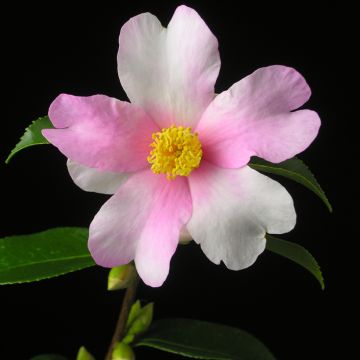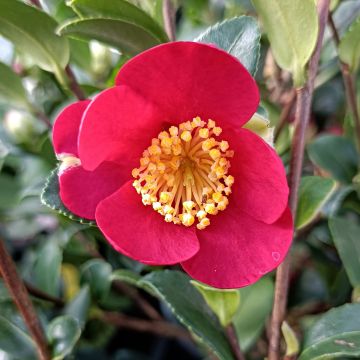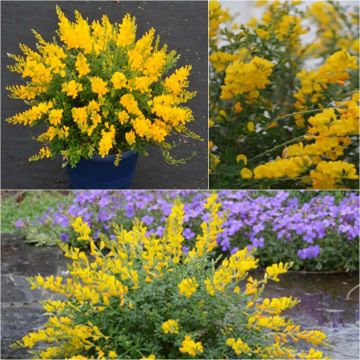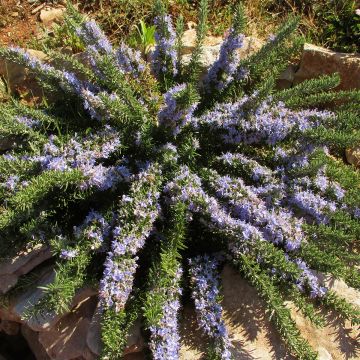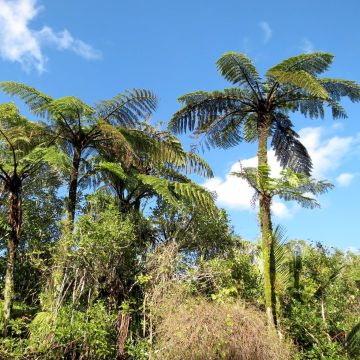

Camellia sasanqua Gay Border
Camellia sasanqua Gay Border
Camellia sasanqua x yuhsienensis Gay Border
Autumn Camellia, Christmas Camellia
The young plant arrived in very good condition and the buds opened quickly. Well done on this product.
Marie-Hélène P., 04/03/2017
This plant carries a 24 months recovery warranty
More information
We guarantee the quality of our plants for a full growing cycle, and will replace at our expense any plant that fails to recover under normal climatic and planting conditions.
From €5.90 for pickup delivery and €6.90 for home delivery
Express home delivery from €8.90.
Does this plant fit my garden?
Set up your Plantfit profile →
Description
Camellia x sasanqua 'Gay Border' is a beautiful autumn camellia bush that is vigorous in nature. Its slightly twisted appearance and flexible branches give it a Japanese feel. Its fragrant flowers bloom between October and December and resemble those of wild roses, with white petals and bright pink edges. This evergreen bush requires a limestone-free soil and is perfect for planting alone in the garden, in a container, or as a flowering hedge.
The Camellia genus belongs to the tea family. It is predominantly native to East Asia. Derived from Camellia sasanqua, the horticultural variety 'Gay Border' forms an upright but compact bush that grows relatively slowly, reaching a height of 1.50 m (4.9 ft) and a width of 1 m (3.3 ft) in 10 years. Its exceptionally long flowering period extends from October to December and emits a spicy fragrance. The simple flowers measure 3 cm (1.2 in) in diameter. The white colour of the petals is enhanced by a touch of bright pink on the edges and a golden yellow stamen. Individually, the flowers are short-lived but continuously renew themselves. The dense and evergreen foliage is composed of small, shiny dark green leaves that are tough and measure 5 cm to 8 cm (2 in to 3.1 in) in length.
Camellia x sasanqua 'Gay Border', like its Japanese parent, tolerates sunlight and dry periods better than other camellias. It thrives in mild climates rather than in cold regions, where its hardiness is sometimes compromised and its flowering is destroyed. Where winters are not too harsh, it can be planted alone in the garden or combined with other acid-loving plants (for example, Rhododendron, azaleas, hydrangeas, witch hazels) in a flowering hedge. 'Gay Border' deserves a prominent position in a flower bed, at the entrance of the garden or along a path. It looks stunning when its trunk has formed and its branches have grown. You can also plant bulbs around its base, such as colchicums or cyclamen. In colder regions, it can be placed on a balcony or terrace and brought indoors during winter in a cold greenhouse or conservatory. Note that its flexible branches can be trained against a trellis or wall. In extreme cases, it can be protected from the cold in an apartment, provided its foliage is regularly misted and watered with non-limestone water.
Report an error about the product description
Camellia sasanqua Gay Border in pictures
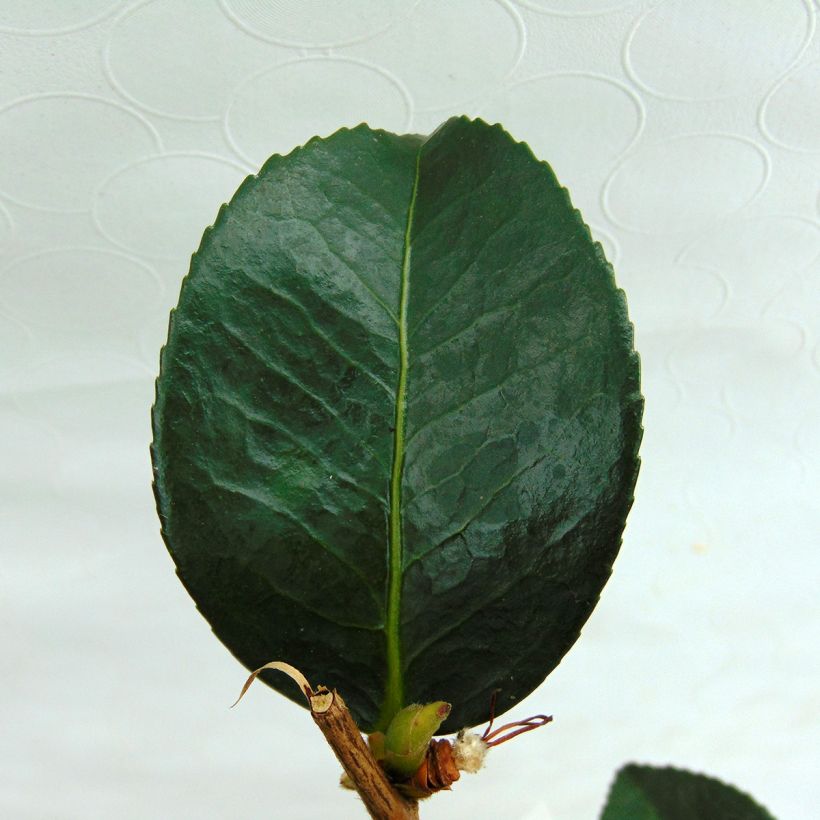

Plant habit
Flowering
Foliage
Botanical data
Camellia
sasanqua x yuhsienensis
Gay Border
Theaceae
Autumn Camellia, Christmas Camellia
Cultivar or hybrid
Other Autumn Camellia
Planting and care
Camellia x sasanqua 'Gay Border' is hardy down to approximately -12° C. (10.4° F). It is a perfect bush in a mild and humid climate. The greater the temperature differences, the more the bush suffers and the less it thrives.
Plant it preferably in March-April. It prefers a non-limestone soil rich in organic matter. However, it is less sensitive than other species to this parameter; a slightly acidic woodland soil or a well-drained clay-silica soil enriched with humus will be perfectly suitable. In a pot, use a mixture of ericaceous soil, decomposed leaf compost, and garden soil (if not too limestone). Also, add a drainage layer at the bottom of the container. The substrate must be loose, light, and draining to allow water passage and root aeration. Clayey, heavy, compact soils are to be avoided.
Place the camellia in a non-burning sun position; it needs brightness but will not tolerate a scorching exposure in summer. Also, be careful to protect it from prevailing winds by planting it near a wall, otherwise, it could lose part of its flowering. Do not to bury the root ball too deeply; cover with 2 cm or 3 cm (0.8 in 1.2 in) of soil to prevent drying out. Water abundantly, then cover the soil with a mulch of bark.
Before winter arrives, protect the mostly surface-developing roots by covering the base with a thick mattress of mixed dry leaves and sand, or any other insulating material (pine bark, flax or hemp flakes, etc). In case of snowfall, take the time to remove the snow by shaking the bush, as it could burn the foliage and weaken the bush. Pruning is not necessary. In fact, beautiful, free forms are obtained by avoiding pruning.
Planting period
Intended location
Care
-
, onOrder confirmed
Reply from on Promesse de fleurs
Evergreen shrubs
Haven't found what you were looking for?
Hardiness is the lowest winter temperature a plant can endure without suffering serious damage or even dying. However, hardiness is affected by location (a sheltered area, such as a patio), protection (winter cover) and soil type (hardiness is improved by well-drained soil).

Photo Sharing Terms & Conditions
In order to encourage gardeners to interact and share their experiences, Promesse de fleurs offers various media enabling content to be uploaded onto its Site - in particular via the ‘Photo sharing’ module.
The User agrees to refrain from:
- Posting any content that is illegal, prejudicial, insulting, racist, inciteful to hatred, revisionist, contrary to public decency, that infringes on privacy or on the privacy rights of third parties, in particular the publicity rights of persons and goods, intellectual property rights, or the right to privacy.
- Submitting content on behalf of a third party;
- Impersonate the identity of a third party and/or publish any personal information about a third party;
In general, the User undertakes to refrain from any unethical behaviour.
All Content (in particular text, comments, files, images, photos, videos, creative works, etc.), which may be subject to property or intellectual property rights, image or other private rights, shall remain the property of the User, subject to the limited rights granted by the terms of the licence granted by Promesse de fleurs as stated below. Users are at liberty to publish or not to publish such Content on the Site, notably via the ‘Photo Sharing’ facility, and accept that this Content shall be made public and freely accessible, notably on the Internet.
Users further acknowledge, undertake to have ,and guarantee that they hold all necessary rights and permissions to publish such material on the Site, in particular with regard to the legislation in force pertaining to any privacy, property, intellectual property, image, or contractual rights, or rights of any other nature. By publishing such Content on the Site, Users acknowledge accepting full liability as publishers of the Content within the meaning of the law, and grant Promesse de fleurs, free of charge, an inclusive, worldwide licence for the said Content for the entire duration of its publication, including all reproduction, representation, up/downloading, displaying, performing, transmission, and storage rights.
Users also grant permission for their name to be linked to the Content and accept that this link may not always be made available.
By engaging in posting material, Users consent to their Content becoming automatically accessible on the Internet, in particular on other sites and/or blogs and/or web pages of the Promesse de fleurs site, including in particular social pages and the Promesse de fleurs catalogue.
Users may secure the removal of entrusted content free of charge by issuing a simple request via our contact form.
The flowering period indicated on our website applies to countries and regions located in USDA zone 8 (France, the United Kingdom, Ireland, the Netherlands, etc.)
It will vary according to where you live:
- In zones 9 to 10 (Italy, Spain, Greece, etc.), flowering will occur about 2 to 4 weeks earlier.
- In zones 6 to 7 (Germany, Poland, Slovenia, and lower mountainous regions), flowering will be delayed by 2 to 3 weeks.
- In zone 5 (Central Europe, Scandinavia), blooming will be delayed by 3 to 5 weeks.
In temperate climates, pruning of spring-flowering shrubs (forsythia, spireas, etc.) should be done just after flowering.
Pruning of summer-flowering shrubs (Indian Lilac, Perovskia, etc.) can be done in winter or spring.
In cold regions as well as with frost-sensitive plants, avoid pruning too early when severe frosts may still occur.
The planting period indicated on our website applies to countries and regions located in USDA zone 8 (France, United Kingdom, Ireland, Netherlands).
It will vary according to where you live:
- In Mediterranean zones (Marseille, Madrid, Milan, etc.), autumn and winter are the best planting periods.
- In continental zones (Strasbourg, Munich, Vienna, etc.), delay planting by 2 to 3 weeks in spring and bring it forward by 2 to 4 weeks in autumn.
- In mountainous regions (the Alps, Pyrenees, Carpathians, etc.), it is best to plant in late spring (May-June) or late summer (August-September).
The harvesting period indicated on our website applies to countries and regions in USDA zone 8 (France, England, Ireland, the Netherlands).
In colder areas (Scandinavia, Poland, Austria...) fruit and vegetable harvests are likely to be delayed by 3-4 weeks.
In warmer areas (Italy, Spain, Greece, etc.), harvesting will probably take place earlier, depending on weather conditions.
The sowing periods indicated on our website apply to countries and regions within USDA Zone 8 (France, UK, Ireland, Netherlands).
In colder areas (Scandinavia, Poland, Austria...), delay any outdoor sowing by 3-4 weeks, or sow under glass.
In warmer climes (Italy, Spain, Greece, etc.), bring outdoor sowing forward by a few weeks.





































